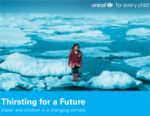Thirsting for a Future: Water and children in a changing climate

Thirsting for a Future opens with a provocative sentence: “No one suffers more from a change in climate than a child” (page 8). The report goes on to highlight how vital safe, accessible water is for the health and future of the world’s children, particularly those living in vulnerable and poor communities. It then proceeds to articulate how the effects of climate change upon the water cycle will intensify risks related to water, and outlines collective actions to address these threats. The report is the third in a series by UNICEF to explore different ways climate change endangers the lives and futures of our children (page 6). The pertinence of the report is emphasized with an estimate that by 2014, almost 600 million children will live in areas of extremely high water stress (page 8).
Chapter 1, “Water is the essence of life”, identifies that water is a child’s right, and that closely allied to safe water are good sanitation and hygiene. The chapter highlights that out of the 17 Sustainable Development Goals agreed on in 2015, Goal 6 explicitly aims to “ensure availability and sustainable management of water and sanitation for all” (page 15). Chapter 1 also illustrates how the attainment of the other 16 SDGs depends upon water, and how climate change threatens to undermine them all by contributing to a rise in water stress.
Chapter 2, “We are at risk of a growing water crisis”, shows that not only are poorer communities at risk of a water crisis, but also affluent urban societies, as their lifestyles become more energy- and water-intensive, leading to increased water use and environmental degradation. The chapter ends with a case study of water conflict and scarcity in the Middle East.
Chapter 3, “Climate change makes it harder for children to access water and sanitation”, identifies different types of communities that are vulnerable to climate change (from urban slums to coastal communities). It also provides two illustrations: first, of the varied ways that climate change impacts the water cycle; and second, of how climate change impacts upon water, sanitation and hygiene (for example, vector-borne disease or contamination of water supplies). In particular, the chapter details how climate change impacts upon water, sanitation and hygiene through: rising temperatures; droughts; increased precipitation, flooding and extreme weather; melting snow, glaciers and sea ice; and rising sea levels.
In conclusion, Chapter 4, “Protecting children from changing water risks”, presents practical ways to build understanding about the risks facing children in order to better “inform policy and planning, set technical standards and develop resilient and climate-smart water, sanitation and hygiene programmes” (page 48). Firstly, it identifies five ways to create resilient water and sanitation systems. Secondly, it shows four ways to keep water flowing at the subnational level. Thirdly, it promotes seven ways to manage climate and water risks. Finally, the chapter notes five key considerations for global advocacy and collective action.
This informative report is good reading for anyone seeking to establish a foundational understanding of how water and climate change interact, how this impacts upon the lives of children, and ways that we may address related threats.
Available from:
https://www.unicef.org/publications/index_95074.html
Book note prepared by Hannah Keren Lee
Search the Book notes database
Our Book notes database contains details and summaries of all the publications included in Book notes since 1993 - with details on how to obtain/download.
Use the search form above, or visit the Book notes landing page for more options and latest content.
For a searchable database for papers in Environment and Urbanization, go to http://eau.sagepub.com/

